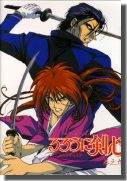![]()

Rurouni Kenshin
(Samurai X)
Episode 28: Aratanaru Kessenhe no Jokyoku - Seyori Kuru Ookami no Kage
![]()
Copyright: Fuji Television, Sony Picture
Length: 25 minutes
Rating: Contains Violence, Parental Guidance Suggested
Format: Original Japanese (LD/VHS)
![]()

A dream of the past brings back memories of the Bakumatsu period in Kyoto for Kenshin. However, not only is the dream a reminder of a past encounter for Kenshin, but his sense of unease hints at the possibility of future troubles. Could it be that the memories which have suddenly come back to haunt him have greater meaning than reminding him of an all too bloody past?
Even the good news of one of Dr. Genzai's patients having given birth to a healthy son isn't enough to shake the feeling of melancholy and pre-occupation which dog Kenshin. Kaoru, noticing that Kenshin is not his usual self, asks Kenshin what has been bothering him and so Kenshin shares some of his dream of Kyoto and the memories from his past; his fight with the Shinsengumi whom he'd fought against. While the Shinsengumi and Ishinshishi were enemies and fought each other with all their strength, there had been no hatred in their battles.
Sano in the meantime has gone to Kamiya dojo to find everyone out for the afternoon/evening. While waiting for the others to return, a wandering pharmacist Fujita Gorou comes to the dojo to sell his wares. However, Sano is suspicious when he finds that the pharmacist has callouses one would normally find on a swordsman. As Kenshin was out, Fujita Gorou a.k.a Saito Hajime decides to leave a calling card for Kenshin...
![]()
|
Enter Saito Hajime, sanban taikuicho for the Shinsengumi during the Bakumatsu period of unrest in Japan. And what an entry it is! Despite the lighter parts of comic relief that to try to lighten the overall mood of the story which is starting here with this season opener, the overall feel of this episode is a bit dark with some definite clues to Kenshin's bloody past. Of definite note here is the character development which is taking place for Kenshin. While we've had some development on Kenshin's history from the Jine episode, and we've likewise learnt about his current personality as Himura Kenshin, now we have greater fleshing out on his past and one of his past opponents. Suzuoki Hirotaka's portrayal of Saito Hajime / Fujita Gorou is very strongly done. The smooth switch from self-effacing Fujita to the cold-blooded wolf Saito through differences in tone and delivery all help to create a very clear image of just who and what Saito really is. All of this development is further aided by a strong music score which helps to enhance the mood created by the story and the voice acting. Two new pieces are added in this first part to the new story, and helps build the overall ambience especially in memories of Kyoto, as well as with the encounter with Saito. The animation in this episode is decent, focusing somewhat on character expressions especially through the eyes There is also good detail on scenes in and around Kamiya Dojo. Also, while the detail present in background shots is good, it tends to be for those areas which are often used and are used for long stills or pans. Essentially on the better side of TV animations but the frame rate and certain aspects of the animation are not as smooth as one may want overall given the story being carried here. As expected, there is some comic relief in the episode from Kenshin's usual "oro" to other scenes, however, while they do break up the story to a degree, the strong story and dialogue in this episode are neither derailed nor distracted from; rather, it helps to lighten what could otherwise become too intense a story too early. The timing of key lines designed to lighten the mood as well as in actions in this episode help to maintain a slighter lighter mood while hinting at the impending battle between Saito and Kenshin. Perhaps the weakest aspect of the voice acting in this episode was for Kenshin's character. While trying to sound pre-occupied, Kenshin's voice sometimes just comes across as a hint bored or uninterested. Despite that however, we watch as action continues around him, very typical of reality. It doesn't matter what personal problems one might have, the world will continue to move. At most, one's preoccupation will cause those around to worry. All in all, the story builds strong viewer interest through hints of what had happened in Bakumatsu Kyoto, and good character development. Likewise, the introduction of a strongly portrayed new character in the form of Saito Hajime also helps to create a strong first impression of this season opening episode. |
![]()
| Original: | Subbed: | Dubbed: | |
|---|---|---|---|
| Story: | N/A | N/A | |
| Direction: | N/A | N/A | |
| Acting: | N/A | N/A | |
| Animation: | N/A | N/A | |
| Music: | N/A | N/A | |
| Translation: | N/A | N/A | N/A |
| Overall Rating: | N/A | N/A |
[ << prev ] [ top ] [ next >> ]
[ home ]
[ what's new ]
[ café contest ]
[ café reviews ]
[ parent's guide ]
[ encyclopædia ]
[ café trivia ]
[ café latté ]
[ café espresso ]
[ about the café ]
[ feedback ]
[ links ]
[ site map ]
© 1997-2000. All rights reserved. The Animé Café logo and the Crystal Kyoko award are original creations of the Animé Café. Please do not use any of the materials on this site without the expressed written permission of the Animé Café.
Page last modified 2000.06.25
